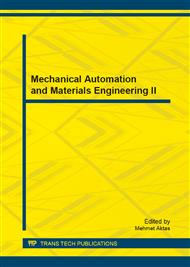[1]
Xiong W. W., Zhang Y. and Yin C. L. Optimal energy management for a series–parallel hybrid electric bus. Energy Conversion and Management. 50 (2009) 1730-1738.
DOI: 10.1016/j.enconman.2009.03.015
Google Scholar
[2]
Kim YJ. Integrated modeling and hardware-in-the-loop study for systematic evaluation of hydraulic hybrid propulsion options. Doctor of Philosophy in the University of Michigan 2008: 1-16.
Google Scholar
[3]
Karden E, Ploumen S, Fricke B, Miller T and Snyder K. Energy storage devices for future hybrid electric vehicles. Journal of Power Sources. 168 (2007) 2-11.
DOI: 10.1016/j.jpowsour.2006.10.090
Google Scholar
[4]
Paul M and Jacek S. Development and simulation of a hydraulic hybrid powertrain for use in Commercial heavy vehicles. SAE Paper 2003-01-3370.
DOI: 10.4271/2003-01-3370
Google Scholar
[5]
Lynn A, Smid E, Eshraghi M and Caldwell N. Modeling hydraulic regenerative hybrid vehicles using AMESim and Matlab/Simulink. Proceedings of SPIE - The International Society for Optical Engineering. (2005), 24-40.
DOI: 10.1117/12.603712
Google Scholar
[6]
Song J H, wang J X, tang H B, mao X J and zhuo B. Diesel hybrid electric vehicle hardware system. International Journal of Automotive Technology. 10(4) (2009) 523-528.
DOI: 10.1007/s12239-009-0060-y
Google Scholar
[7]
Xiong W W, Zhang Y, Yin C L. Optimal energy management for a series–parallel hybrid electric bus. Energy Conversion and Management. 50 (2009) 1730-1738.
DOI: 10.1016/j.enconman.2009.03.015
Google Scholar
[8]
Wu B, Lin C C, Filipi Z, Peng H and Assanis D. Optimal power management for a hydraulic hybrid delivery truck. Vehicle System Dynamics. 42(2004) 23-40.
DOI: 10.1080/00423110412331291562
Google Scholar
[9]
Luo Y G, Chen T, Zhou L, Zhou G Q and Li K Q. Adaptive cruise control system of besturn intelligent hybrid electric vehicle. Journal of mechanical engineering. 46(6)(2010) 2-7.
DOI: 10.3901/jme.2010.06.002
Google Scholar
[10]
Vanessa P, Teresa D, Arturo DR and Domenico L. Super-capacitors fuel-cell hybrid electric vehicle optimization and control strategy development. Energy Conversion and Management. 48 (2007), 3001-3008.
DOI: 10.1016/j.enconman.2007.07.014
Google Scholar
[11]
Hosein F, Dawood S B and Ehsan A. A bidirectional soft switched ultracapacitor interface circuit for hybrid electric vehicles. Energy Conversion and Management. 49 (2008) 3578-3584.
DOI: 10.1016/j.enconman.2008.07.004
Google Scholar
[12]
Uzunoglu M, Onar OC, Alam MS. Modeling, control and simulation of a PV/FC/UC based hybrid power generation system for stand-alone applications. Renewable Energy. 2009, 34: 509-520.
DOI: 10.1016/j.renene.2008.06.009
Google Scholar
[13]
Gao Y M, Chen L P, Ehsanl M. Investigation of the effective of regenerative braking for EV and HEV. SAE Paper 1999-01-2910.
Google Scholar
[14]
Gao Y M, Chen L P, Ehsanl M. Electronic braking system of EV and HEV-integration of regenerative braking, automatic braking force control and ABS. SAE Paper 2001-01-2478.
DOI: 10.4271/2001-01-2478
Google Scholar
[15]
Ahn J K, Jung K H, Kim D H, Jin H B et al. Analysis of a regenerative braking system for hybrid electric vehicles using an electro-mechanical brake. International Journal of Automotive Technology. 2009, 10(2): 229-234.
DOI: 10.1007/s12239-009-0027-z
Google Scholar
[16]
Simon B, Christine E, Edward G and Markus G K. Hydraulic hybrid systems for commercial Vehicles. SAE Paper 2007-01-4150.
Google Scholar
[17]
Kepner R P. Hydraulic power assist – a demonstration of hydraulic hybrid vehicle regenerative braking in a road vehicle application. SAE Paper 2002-01-3128.
DOI: 10.4271/2002-01-3128
Google Scholar
[18]
Kim Y J and Filipi Z. Series hydraulic hybrid propulsion for a light truck– optimizing the thermostatic power management. SAE Paper 2007-24-0080.
DOI: 10.4271/2007-24-0080
Google Scholar
[19]
Simon B, Christine E, Edward G and Markus GK. Hydraulic hybrid systems for commercial Vehicles. SAE Paper 2007-01-4150.
Google Scholar
[20]
Zhang Y C , Yu Z P , Xu L and Xiong L. A study on the strategy of braking force distribution for the hybrid braking system in electric vehicles based on braking intention. Automotive Engineering. 2009, 31(3): 244-249.
DOI: 10.1002/9781118354179.auto028
Google Scholar


